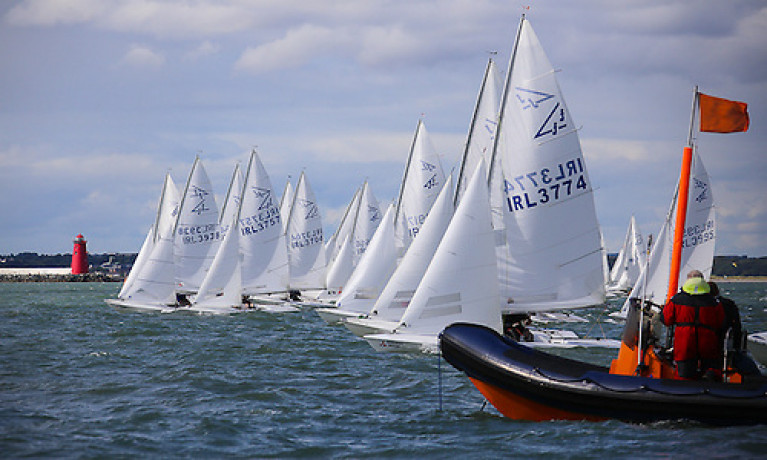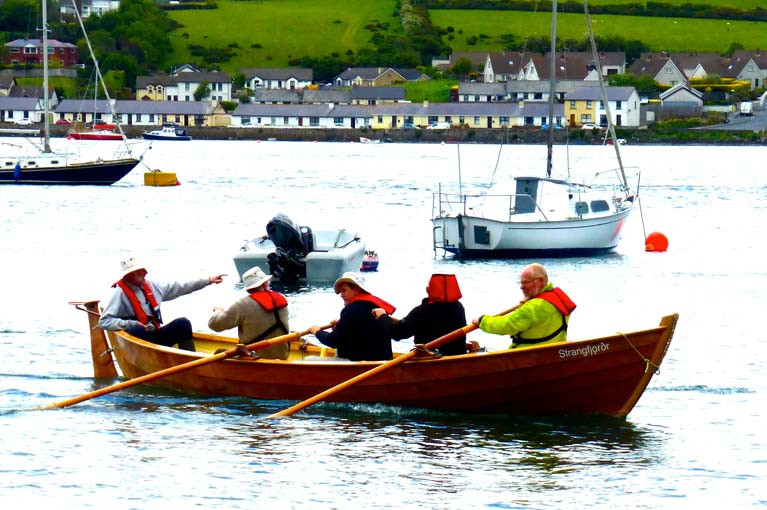Displaying items by tag: Sailing classes
What Is The State Of Sailing In 2020?
With Covid-19 restrictions the world over giving pundits some pause to consider sailing’s overall health and prospects, Scuttlebutt Sailing News’ Craig Leweck has three observations when considering the ‘state of the sport’ in 2020:
- When the cost in time and money to participate exceeds the pleasurable benefit, people seek alternative activities.
- Better isn’t always best, as the natural inclination for improvement slowly eliminates those that choose not to chase the rising bar.
- We are capable of evolving toward extinction.
It’s an old story that as the technology that underpins a sport or pastime improves, its costs can and often do rise with it. In sailing that means everything from sails and cordage to electronics and hardware — and much of it unnecessary for the outliers, those with non-professional aspirations, who breathe life into sailing communities.
Leweck laments: “At some point in time our pursuit of perfection took over our weekend regattas, and every course configuration became windward-leewards, and every event took on the format of a world championship.”
But the good news, Leweck says, is that the basic still apply and “you can still affordably get into this sport”, via the likes of fibreglass keelboat classes “that provide sturdy platforms for racing” and are conducive to keeping interest up.
His sentiments echo those of our own W M Nixon, who has also mulled over the cruising-racing divide, who wrote recently: “In the end, it is the prospect of regular quality racing which is the real engine in keeping any class motoring along. Yet even here, realistic local expectations are much more relevant than high-flown aspirations towards course-setting perfection in yacht racing.”
Scuttlebutt Sailing News has much more on the story HERE.
Keeping Ireland’s Sailing & Boating Communities in Good Health is Always Work in Progress
This weekend two years ago, Storm Emma was sweeping Ireland, with onshore hurricane-force winds attacking much of the East Coast and wrecking a shed on Howth’s East Pier where, for decades, boats of the 1898-founded Howth Seventeen Foot class had been kept for winter storage.
Seven boats had varying degrees of such extensive damage that it was initially feared it could be a mortal blow for a historic class which was seen as a symbol of its characterful home port, for seven boats meant that pessimists feared that a third of the fleet had been wiped out.
But the class’s collective spirit - its instinctive sense of community - saw a group of 20 owners and crews and friends being assembled on the strength of their range of talents and access to lifting machinery. As soon as the storm had subsided, they were at work saving the boats from further damage by removing them from a place now in danger of total collapse. When darkness fell at the end of that “Day of Saving”, the seven boats were in a place of safety.
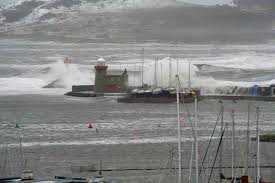 On this day two years ago, Storm Emma had arrived. Somewhere under that wave breaking over Howth’s East Pier is the shed housing seven of the classic Howth 17s
On this day two years ago, Storm Emma had arrived. Somewhere under that wave breaking over Howth’s East Pier is the shed housing seven of the classic Howth 17s
 The aftermath. Yet in just one day, all seven boats had been removed to safety, and only one was a total loss
The aftermath. Yet in just one day, all seven boats had been removed to safety, and only one was a total loss
Just one was a total loss, while the rest needed various levels of work – admittedly including major projects - to bring them back to full seaworthiness. But now the class is restored to fuller health and greater numbers than it has ever enjoyed before, with the “total loss” boat re-built thanks to some brilliant management by Ian Malcolm, and new enthusiasts are keen to join a class which so obviously provides such a vibrant sense of community.
However, we do not need such a specific yet ultimately manageable setback to demonstrate an attractive sense of community within most sections of the sailing and boating population. It’s to be found in all successful classes, this community spirit which - to put it at its most basic - can be a very successful marketing tool for those concerned with maintaining and maybe increasing numbers in sailing. But an extreme example such as the effects of Storm Emma emphasised just how important these communities, these “small platoons”, are within society as a whole.
 Back to normal. The Howth 17s are now back to full strength, and much of their racing is done from a convenient pier–based start line. This is third generation Howth 17 owner-skipper Peter Courtney racing Oonagh in Howth Sound. Photo: David O’Shea
Back to normal. The Howth 17s are now back to full strength, and much of their racing is done from a convenient pier–based start line. This is third generation Howth 17 owner-skipper Peter Courtney racing Oonagh in Howth Sound. Photo: David O’Shea
Yet it is a mistake to think that a sense of community is something to be aimed for along some tunnel-vision route. On the contrary, it is surely more realistic to accept that a sense of community is a valuable by-product, the attractive evidence of shared enthusiasms and a welcome result of working together and taking part in group activities which are enlivened by a level of healthy competition when the boats are afloat.
It’s something which can be found in all areas of life, and in sailing and boating it manifests itself in many ways. One of the most clear-cut in Ireland is the class associations, which are as various in their character as their boats are in their types. All share a sense of community that is as natural as breathing which - while vitally important - exists as something almost incidental.
The Gold Standard in class associations is probably set by the GP 14s, who are seeing an increase in activity with the 2020 Worlds being staged in Skerries from July 25th to 31st. The Lasers may be bigger numerically, but they are solo sailed to create their own simpler dynamic, whereas the two-handed GP 14s have the need of added sailing abilities as they set a spinnaker, together with the demands of extra social skills and crew recruitment logistics.
 The Gold Standard in Irish class associations – hard driving for the GP 14s
The Gold Standard in Irish class associations – hard driving for the GP 14s
There are many other One Design classes which share the powerful community ethic of sailing which lends itself to promoting this Sport for Life. Anyone who has ever seen the group activity which is the thriving Flying Fifteens at the National YC in Dun Laoghaire operating their purpose-designed launching and retrieval system will be impressed and aware of the vigour of this particular setup.
In the end, it is the prospect of regular quality racing which is the real engine in keeping any class motoring along. Yet even here, realistic local expectations are much more relevant than high-flown aspirations towards course-setting perfection in yacht racing.
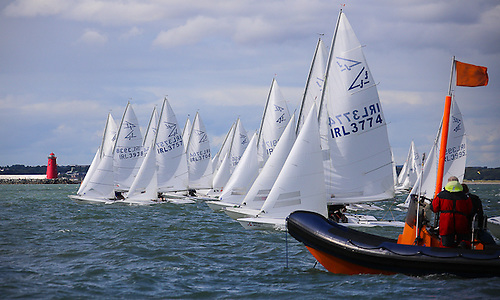 Flying Fifteens in Dublin Bay. Their co-ordinated launching and retrieval system at the National Yacht Club is a wonder to behold. Photo Afloat.ie/David O’Brien
Flying Fifteens in Dublin Bay. Their co-ordinated launching and retrieval system at the National Yacht Club is a wonder to behold. Photo Afloat.ie/David O’Brien
The mantra in business schools is Voltaire’s statement that Perfection is the Enemy of the Good. You’ll achieve much more overall if you’re happy enough with 85% achievement than if you’ve busted your gut and driven everyone crazy in getting to 97% of the arbitrary ideal, and back in Sailing on Saturday at the end of last August we were warbling on along these lines.
Some cheeky but unpublishable personal emails showed we were hitting the target for some folk, but we’d felt a bit like a voice crying in the wilderness until North Sails recently published the musings of their President Ken Read, which put the whole matter with much more authority
 The President of North Sails in Galway during the Volvo Ocean Race. Ken Read is one of sailing’s great sports. Photo: VOR
The President of North Sails in Galway during the Volvo Ocean Race. Ken Read is one of sailing’s great sports. Photo: VOR
Ken Read is a good sport who can put the fun back into sailing when the opportunity arises, so let’s hear it for modern sailmakers for the great work they do in making Irish classic boats look much more attractive. In the old days, boats such as those two Dublin Bay specials, the Mermaids and the Water Wags, tended to have an unattractively starved look to their sails, which were no bigger and generous than was necessary, and were often unmatched and of different generations.
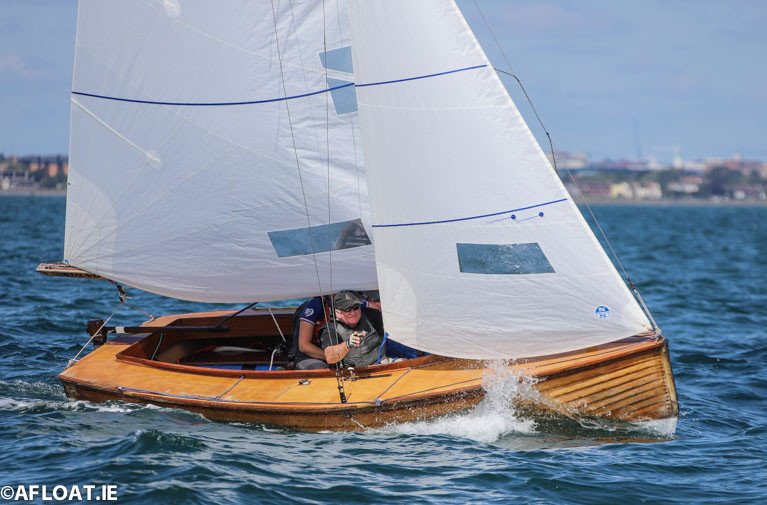 Suits you, sir…..The new style North Sails work wonders for the look of a venerable Mermaid. Photo: Afloat.ie/David O’Brien
Suits you, sir…..The new style North Sails work wonders for the look of a venerable Mermaid. Photo: Afloat.ie/David O’Brien
But today’s sails have freshened things up no end. A contemporary and stylishly complete suit with a loose-footed main with its own ample curve in the foot has given these old girls a new lease of life. And in the case of the Water Wags, the boats have the bonus of being the height of fashion in Dun Laoghaire, so much so that specialist builder Rui Ferreira of Ballydehob in West Cork is bringing new Water Wag No 51 to immaculate completion for noted Dragon sailor Denis Bergin.
For those who complain that these boats are of a concept which is ancient - the Water Wags date back to a 1900 design in a class which originated in 1887, while the Mermaids are from 1932 - we’d point out that, astonishingly, the Laser is now past the Golden Jubilee mark.
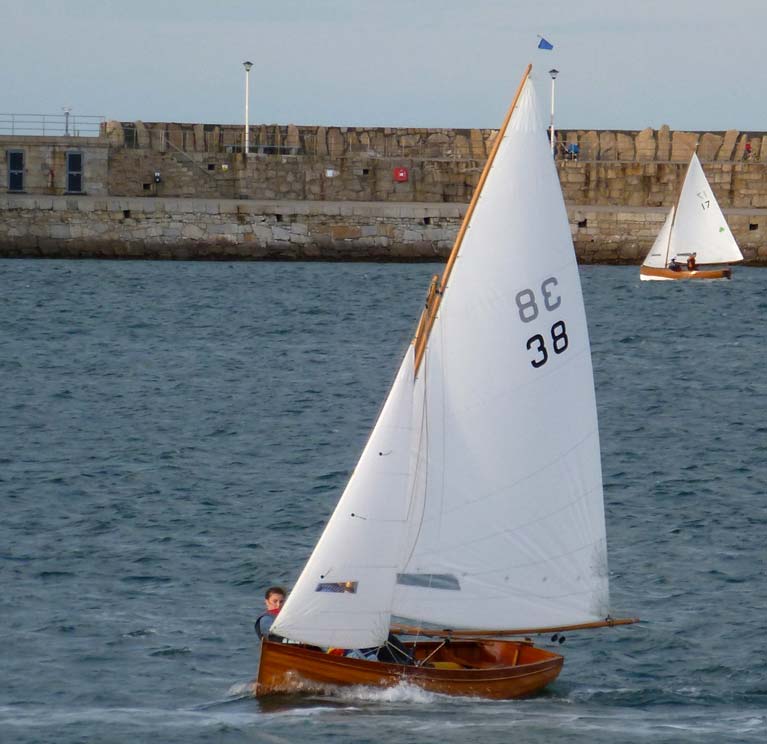 Full and generous. Modern sails go well on Guy Kilroy’s Dublin Bay Water Wag Swift. Photo: W M Nixon
Full and generous. Modern sails go well on Guy Kilroy’s Dublin Bay Water Wag Swift. Photo: W M Nixon
And one of the most useful International One Designs in Ireland, the J/24, is not only 55 years old, but she was right up to speed in being created by designer Rod Johnstone and his co-builder brother Bob in their parents’ garage in Stonington, Connecticut in 1975. The boat become 24ft LOA because that was the biggest they could build her without actually knocking out an end wall, and the use of a Stonington garage on America’s east long pre-dated the American garage’s sacred role in the creation of Silicon Valley out west.
But here again the vitality of the J/24s, as with the other classes mentioned, is dependent on personally-owned (or in the case of the J/24s, syndicate-owned) craft being campaigned in a satisfying season-long programme, which may not appeal in the modern age with its fondness for life in a tasting menu. So the clubs are providing club-owned boats for occasional sailors who fear total commitment, and while there’s an element of “What’s everybody’s business is nobody’s business” about these communally-owned craft”, every so often they attract a rush of enthusiasm.
Another approach in attracting people towards boats and the sea is that it should all be part of a complete process including the building of the boat, which was seen with the 2012 completion of the absolutely charming 25ft gaff cutter Sally O’Keeffe designed by Myles Stapleton for the Seol Sionna group in West Clare, with Sally being constructed in a community effort guided by master boatbuilder Steve Morris in a large barn obligingly provided by a farmer at Querrin down towards Loop Head.
 The community-built gaff cutter Sally O’Keeffe has introduced hundreds of people to the sea and sailing at Kilrush on the Shannon Estuary
The community-built gaff cutter Sally O’Keeffe has introduced hundreds of people to the sea and sailing at Kilrush on the Shannon Estuary
Since she started sailing, Sally O’Keeffe has turned heads the length and breadth of the mighty Shannon Estuary, and has impressed with appearances at Cruinnui na mBad at Kinvara on Galway Bay, the Baltimore Wooden Boat festival in West Cork, and the Glandore Classics further eastward on the south coast of Cork, having gallantly sailed to all these places along the challenging Atlantic seaboard.
Back at her home port of Kilrush, she has been used for sailing and seafaring courses which have involved getting hundred of people afloat, the most senior being 90-year-old Miss Josephine Glynn of the long-established Kilrush family.
As the years have passed since Sally was first commissioned, it has become increasingly clear that another instructional boat-building project at Kilrush would be useful, and the opportunity to provide this has arrived through the BIM (Bord Iascaigh Mhara) FLAG scheme, which is operational from 2016 to 2023.
Most will know of it, but FLAG is Fisheries Local Area Group Development Scheme. The idea is to make funds available to smaller coastal ports and communities which have suffered economically and socially from the decline in small craft fishing activity, thanks to factors as various as the salmon netting ban, limitations on size of catch, and ever more efficient larger boats taking the small boats’ catch in a more economical style.
In Kilrush, they’ve got the idea that Seol Sionna should broaden its remit to include coastal rowing and the building of one of the Iain Oughtred-designed St Ayle’s Skiffs. They have proven a success around Strangford Lough as they’re just 22ft long, light and handy to built by the edge-glued marine ply method, making them a much more manageable proposition than the traditional and majestic 32ft-plus LOA traditional clinker skiffs which are the backbone of much Irish coastal rowing.
 Members of Seol Sionna aboard Sally O’Keeffe in Kilrush (Steve Morris is second from left in bow). Their next project is building a St Ayle’s Skiff. Photo: W M Nixon
Members of Seol Sionna aboard Sally O’Keeffe in Kilrush (Steve Morris is second from left in bow). Their next project is building a St Ayle’s Skiff. Photo: W M Nixon
With Luke Aston and Gerard Concannon putting Kilrush’s case for a complete St Ayle’s Skiff project which will comprise a complete building kit and a purpose-designed road trailer from Jordan Boats, they find they’ve hit the button spot on with a 100% grant from FLAG.
The first boat will be built as a proper Training Project under the direction of Steve Morris, James Madigan and Dan Mill, and while it’s for members of Seol Sionna, new members are very welcome and membership fees are a reasonable €60 for family, €40 for single, and concession for €20.
For those interested, try phoning Steve Morris at 087 799 0091 for details of what will assuredly be a rewarding and satisfying process ashore and afloat, as the St Ayle’s Skiff has so perfectly hit the target that they’re now being built worldwide.
 Their popularity is spreading worldwide – a St Ayle’s skiff under construction in Australia
Their popularity is spreading worldwide – a St Ayle’s skiff under construction in Australia
As for BIM’s FLAG scheme, its applications can be very wide indeed, and it was of course used late last year to fund the six new Fireflies with which Irish Sailing is putting on Team Racing Instructional Roadshow under the direction of Rory Martin. We hasten to make the point that this is not done with the intention of holding a team racing tournament at each venue visited, rather it’s to give instructional insight into the tricks of the team racing trade.
The first instructional demo by the new Firefly squad took place in Dun Laoghaire last November, and in a week’s time they’re in Howth. This is a bit ironic, as it’s the high-powered fishing craft that frequent Howth which have done so much to change the face of the industry.
Not that there are many Howth owners involved these days. The sons and daughters of the old Howth fishing families are as likely as not to be found trawling documentation as corporate lawyers in the IFSC rather than trawling fishing nets through Ireland’s seas. But what goes round comes round, and it could well be that sons and daughters of those same corporate lawyers will be attracted to sailing thanks to the availability of it through Irish Sailing’s Team Racing Fireflies.
 Close racing among St Ayles skiffs – their basic design origins are Viking by way of the East Coast of Scotland
Close racing among St Ayles skiffs – their basic design origins are Viking by way of the East Coast of Scotland
Classes Hear ISA Plans to Support Irish Dinghy Scene
An Irish sailing classes forum held at the weekend gave an opportunity to hear Irish Sailing Association progress at revitailing Irish dinghy sailing. Open to all clubs and classes the forum was hosted by appointed ISA Director responsible for dinghies and Classes, Sarah Byrne. Other ISA attendees included Sarah Louise Rossiter, the Eastern Region’s Development Officer, CEO Harry Hermon, ISA President Dave Lovegrove, Board Member Brian Craig, Strategic Group Members Jack Roy and Harry Gallagher and Alec Elliott who would give a presentation on website developments at the ISA. ISA President Dave Lovegrove opened the proceedings by making references to the successes of 2015 but also cautioning that more work needed to be done.
The 33 people in the room representing 16 classes and 5 clubs were advised that the ISA’s assessment of the participation level in classes was still based on numbers at the National Championships, as was the case in 2013. An attempt to survey clubs and classes on activity levels, and structures within their domains to recruit new members had not yielded sufficiently tangible results to allow an accurate assessment to be made. Consequently, participation trends from 2013 to 2015 were again presentated as a bar chart of Nationals entries.
Many developments were presented and a Club survey has shown:
- a dilution of a segmented fleet structure in Ireland;
- the strength of Junior single-hander fleets in larger sailing centres;
- the lack of transition to adult, mainly double-hander classes;
- inactive boats.
A comment from the floor suggested that the continuing focus on single-handed classes was evident in the Pathway structure in terms of the ratio of single-handed classes to double-handed classes that were being promoted. It was suggested that this favouritism towards the single-handers was detrimental to the overall growth of numbers – on two counts – it prompted a dropping out situation if success wasn’t achieved and it detracted from the development of crews and multi-handed sailing. The latter presents a problem where “family sailing” might be a viable way to grow numbers in a club environment.
Already in 2015 and moving into 2016, the ISA will, from a class perspective continue to further enhance a robust platform and structure for Irish sailing:
- Class coaching grant provision – 2016 launch in January;
ISA have indicated that coaching grants are awarded on the basis of three parameters – engaging a coach on the ISA approved list, providing coaching to a class affiliated to the ISA and the hosting of such coasting at a Category 1 club. One speaker advised of a situation where a coaching grant was awarded where a Category 1 club was not involved. Harry Hermon acknowledged that this was a special case as it had been identified that there was a possibility of a club being established in this area and it was felt that coaching might assist that initiative. This led to a further suggestion from the floor that coaching grants might be awarded on the basis of meeting two of the three parameters listed above – Recognised/Approved Coach, Affiliated Class, Category 1 Club. It was also suggested that the list of Approved/Recognised Coaches needs to be updated. The point was also made that while coaching should be available to all class members, there is a deficit of Recognised/Approved Coaches who can provide this service to the top end of the stronger classes, forcing such classes to get coaches from the UK.
- Changes in training, instructor training and a new Club coach qualification;
Board Member Brian Craig highlighted changes to the Instructor and Coaching Schemes and advised that these will be implemented in 2016 and advised that these schemes would be audited for assessment.
- Push to qualify more race officials to support competition;
Harry Gallagher advised the meeting that he has been asked to take over the Race Officials Policy Group from Jack Roy. Harry highlighted the various courses that are provided for the training of Race Officials – Race Officers, Judges and Umpires but also Time-keepers, Recorders, Flag personnel. He also advised that a course for Mark-layers with specific reference to laying course by GPS will be developed and provided next year. Jack Roy’s experience as part of the 2012 London Olympics Regatta Management Team had highlighted the importance of laying accurate courses.
Harry is also keen to bring class measurers into the “fold” of Race Officials and suggested that a communique would go out from the ISA to classes to get the details of their class measurers.
- Greater budget and support for ‘Try Sailing’ initiatives which proved successful in 2015.
The 2015 version of the “Try Sailing” scheme had been focussed on clubs. In 2016, the idea will be to get a greater buy-in to the initiative from the classes.
All agreed that true access to the water is through Clubs, Classes and training centres. They are the deliverers of sailing programs and competition circuits. Classes agreed to target other fleets and approach clubs to develop strategic direction through Club and Class ‘pathways’. A smooth transition is key to facilitate the development of sailors as their skills and aspirations develop both locally and on the wider circuit. The ambition is to connect and strengthen what is a segmented Irish fleet, to cultivate an appetite for local fun and accessible events and to feed into wider competition.
Sarah Louise Rossiter highlighted how classes might interact with clubs in order to showcase the class to a club where there may be an opportunity to establish a new fleet. She suggested there was little value in simply arriving at a club for a weekend event and hoping that something might manifest itself as a consequence. A willingness to engage with the club and its members was required and this could take the form of providing advice on the costs of buying a boat, letting people know the combination of crew sizes that could sail the boat, availability of second-hand boats, how far people would have to travel to engage with other people/clubs sailing the same type of boat, the availability of road trailers to allow people to travel.
All were reminded that the Junior single hander classes continue to thrive, but there is still a huge fall off in take up in adult fleets. This is not unique to Ireland nor just to sailing. It was agreed that this area should be explored over the coming months, with the participation of the single hander fleets to try and sustain those sailors who choose not to go down the laser route and build on the years of commitment and dedication of the parents, coaches and children to transition into adult fleets. It was remarked that catching just some of the fallout, even in a less committed way, would help Irish sailing generally.
A noteworthy mention of a succesful strategy in this area came from Sam O’Byrne of the J24 fleet. He highlighted the successful Howth Yacht Club strategy to ensure their 80 strong 18-25 yrs cadet squad continue to sail.
Sam also highlighted that IUSA (Irish Universities Sailing Association) recently had an event with 350 participants and suggested that the ISA should contact IUSA so that they could be made aware of the IUSA events as they might impact on class sailing events on the regular calendar.
The meeting ran over time and opportunities to merge for events were limited – however, those declaring an interest to find an event partner will now be facilitated in the events calendar section on the ISA website.
Two speakers from the floor suggested that the meeting was in danger of discussing old recurrent problems and that there should be a focus on event planning which is what the second speaker had thought the meeting was about. At this stage a number of speakers indicated that event dates submitted to the ISA had not appeared on the regatta fixture list from the website put up on screen. An apology was offered in this regard. Various speakers then tried to detail regatta dates for 2016 and indicated whether they wanted other classes to share the declared venue with them. The ISA also advised that the tender to host the “Dinghyfest” that RCYC had hosted in August past in 2016 was out and due to be returned with a couple of weeks. The “floor” indicated that this timetable was far too late, which was acknowledged. A possible date for the Dinghyfest was suggested but was immediately countered by the fact that a Laser Worlds regatta is scheduled for the same period.
All classes were also urged to update their contact information with the ISA and on their own websites to facilitate all enquiries, particularly from Clubs and classes to multi-fleet event or indeed build ‘pathways’.
Local Sailing Class Success Takes Good Boats, But Even Better People
As we near the end of the traditional sailing season, inevitably there’ll be heart-searching among boat owners as to the success and value obtained from their summer afloat – can they really justify the expense of continuing to keep a boat? And with so many imponderables in our sport after a summer which was decidedly mixed in its weather - to say the least - the larger sailing community will be scrutinising those classes which seem to be barely hanging in, those classes which are doing quite well, and those few classes which are spectacularly successful. W M Nixon takes a look at the International Dragons in Glandore, the Flying Fifteens in Dun Laoghaire, and the Puppeteer 22s in Howth to try and find that magic Ingredient X which helps - or has helped - these three very different examples to stay ahead of the game.
The wish to own a boat is a vocation, a calling, a quasi-religious emotional endeavour. It’s all very well for high-flown consultants to tell us that if sailing is going to have general appeal and expand, then publicly-accessed freely-available try-a-sail boats will have to be based at every major club. But dedicated sailors know that what comes easy, goes easy. A spell of bad weather, and your jolly public groups who turned up in droves for a bit of free fun afloat will disappear like the will-o’-the-wisps they were in the first place, seeking instead to find somewhere warm and bright and out of the rain and readily providing the latest novel form of entertainment.
Meanwhile, those who are dyed-in-the-wool boat addicts will have barely noticed the idly-interested strangers coming and going. For whatever the weather, they’ve a boat to maintain, gear to repair, a crew to keep together, and some sensible purpose to find in order to give it all deeper meaning. For they know that unless they’ve a boat and her problems and possibilities occupying a significant part of their mind, they’re going to lose the plot completely.
Nevertheless, in the huge spectrum of boat ownership and sailing classes, why is there so much difference in the successful buzz created by some classes at certain localities, as opposed to the dull and declining murmur emanating from classes which are clearly on the way out?
After all, there are very few utterly awful boats afloat. No boat is completely perfect, though some may seem less imperfect than others. But in today’s throwaway world, if some class of boat is not a reasonably good representative of her general type, then she’ll never make the grade in the first place. And even in times past when news and views moved more slowly, the word soon got around if some much-touted type of boat was in truth a woofer.
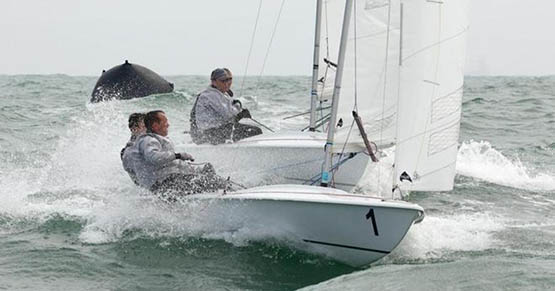
Flying Fifteens provide the best of sport in a very manageable two-man package

The perfect harbour for vintage International Dragons – Glandore, with a goodly selection of classics in port, and Dragons of all ages dotted among them
That said, boat-owning is such an all-consuming passion that once a sailor has finally (or indeed hastily) committed to a particular boat type, then he or she will tend to be absurdly dismissive of any remotely comparable craft. But in the last analysis, the desire to own a boat is irrational. So we shouldn’t be surprised that once the decision is made, irrational attitudes manifest themselves in every direction.
And anyway, as John Maynard Keynes once remarked in a totally different context, in the last analysis we are all dead. So in the meantime, it behoves us to get as much reasonable enjoyment out of life as possible. Thus if owning and sailing a boat is your way of obtaining pleasure without harming anyone else, then good luck to you and me, and let’s look together at boat classes which are doing the business.
In considering the International Dragons in Glandore, the International Flying Fifteens in Dun Laoghaire, and the emphatically not-international Puppeteer 22s in Howth, we are indeed casting the net wide, for really they couldn’t be more different. The 29ft International Dragon originated in the late 1920s from the design board of Johan Anker of Norway, and she has become a by-word for Scandinavian elegance in yacht design, but today she’s totally a racing machine and has strayed far from her original concept as a weekend cruiser for sheltered waters.
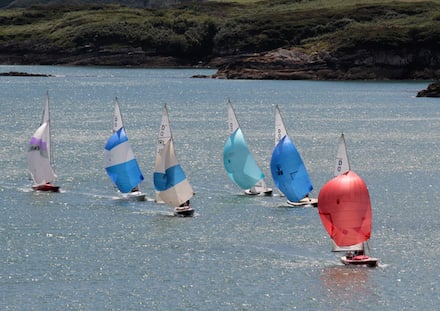
Golden days of classic Dragon racing at Glandore
As for the Flying Fifteen, they originated from designer Uffa Fox having a brainstorm in 1947, in that he took the underwater hull section of the renowned International 14 dinghy in which he was something of a master both as designer and sailor, but above the waterline he drew out the bow to an elegant curved stem, then he lengthened the gentle counter lines to finish in a long sawn-off transom. That done, he added a little hyper-hydrodynamic bulb ballast keel which seemed very trendy, but in truth it’s severely lacking in useful lateral resistance. Nevertheless it gives the boat the reassuring feel of being a small keelboat rather than a big dinghy, and atop it all he put the rig of an International 14 dinghy of that era.
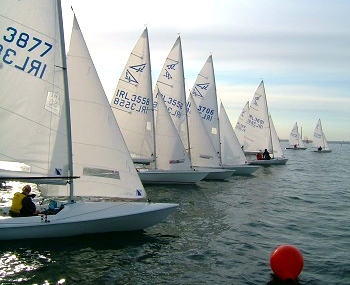
The clean lines of a modern Flying Fifteen fleet. Try to imagine that within each hull there’s an International 14 dinghy, and above it is the original rig
The result was a boat which is really only useful for racing, and it is a design so much of its times that it’s said that many years later the designer himself tried to disown it. But the owners would have nothing to do with this, they liked the compact and very manageable racing-only package which the Flying Fifteen provides, and these days the class has an interesting world spread, and an attractive policy of staging their World Championships at agreeable sunshine destinations where – thanks to their guaranteed ability to turn up with a fleet of viable size – they can arrange block discounts to provide the owners with a very appealing package.
After the sheer internationality of the Dragons and the Flying Fifteens, the Puppeteer 22s are something of a culture shock, as almost every one in existence has ended up based in Howth, where they have such a busy club programme that they only very seldom go south of the Baily, though they do have one annual adventure to Malahide for the Gibney Classic, and once a year they take part in the historic Lambay Race. But otherwise, they’re totally and intensely focused on club racing off Howth.

The Puppeteer 22s seldom stray far from their home port of Howth, for at home they get superbly close racing with a fleet of up to 26 boats in evening racing. This is former ISA President Neil Murphy racing hard at the helm of Yellow Peril, neck and neck with Alan Pearson’s Trick or Treat. Photo: W M Nixon
They were designed by Chris Boyd of Strangford Lough in the mid 1970s to be fractionally-rigged mini-offshore racers, and in all about thirty-three of the Puppeteer 22s were built by C & S Boyd in Killyleagh (Sarah was Chris’s wife). For a while it looked as though they might take off as a semi-offshore One Design class in the north, but somehow they began to trickle down to Howth. They appealed to those sailors who felt that the alternative of a Ruffian 23 with her huge masthead spinnaker was a little too demanding on crews, whereas the Puppeteer’s fractional rig is fairly easily managed. And today the class in Howth is in such good health that even in the poor weather of 2015 they were obtaining regular midweek evening racing best turnouts of up to 26 boats.
Obviously the Puppeteer 22s are now very much a completely localised phenomenom. But while the Flying Fifteens in Dun Laoghaire and the Dragons in Glandore may be representatives of well-established international classes, the fact is in both cases their neighbourhood success is largely due to a distinct local flavour driven by individual enthusiasm. And in Glandore while it’s recognized that the vintage Dragon class was started by Kieran and Don O’Donohue with the classics Pan and Fafner, the man who beats the drum these days for the racing at Glandore as providing “the best and cheapest Dragon racing in the world” is the inimitable Don Street.
Most people will expect that they will be slightly older than the boats they own, and the older you get the greater you’d expect the age gap to be. But Don’s classic Dragon Gypsy is 82 years old. Yet Don himself manages to be that proper little bit senior to her, as he’s 85 and still full of whatever and vinegar, as they’d say in his native New England.
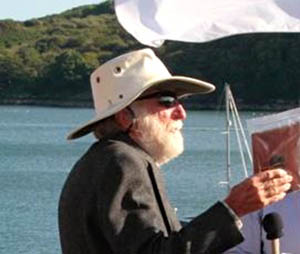
The one and only Don Street in his beloved Glandore. His International Dragon Gypsy is 82 years old, but he still manages to be the senior partner at 85.

Conditions are pleasantly sheltered for the Dragons in Glandore Harbour, but when the fleet goes offshore – as seen here for last year’s championship - they can find all the breeze and lively sea they might want, and more.
The things that Don has done with Gypsy – between intervals of the renowned ocean voyaging with his 1905-built yawl Iolaire which he has now sold – are remarkable, as he sailed Gypsy from Glandore to the classic regatta in Brittany, which is a prodigious offshore passage for an open cockpit racing boat along what the rest of the world would see as significant portions of the most exposed parts of the Fastnet Race course.
Yet although he did such wonderful business with Gypsy on great waters, he has no doubt that the secret of Glandore Dragon racing’s local success is the sheer nearness and convenience of it all. “Down to the pier and out to the boat in five minutes, the starting line is right there, and we don’t race those boring windward-leewards, rather we use club buoys, government navigation marks, islands - and lots of rocks……”
His argument is that with lovely Glandore Harbour being such an fascinating piece of sailing water, part of the interest in keeping up the pace in a local class lies in using those local features, rather than pretending they simply don’t exist by setting courses clear of the land. But of course when the Glandore fleet – which continues as a mix of classic wooden and glassfibre boats – hosts a major event such as last year’s Nationals – which was won by Andrew Craig of Dun Laoghaire in Chimaera – then the courses are set in open water, and they’d some spectacular sailing with it.
In many ways Glandore is a special case, as the population swells in summer with people coming for extended vacations. When that’s the case, their commitment to local Dragon racing can be total, and not least of the occasional local summertime alumni is the great Lawrie Smith. He may have won the Dragon Gold Cup from a fleet of 66 boats last month in Germany under the burgee of another club, but when he’s racing Dragons in Ireland, he’s emphatically under the colours of Glandore Harbour Yacht Club.
Despite these glamorous international links, it’s the folk on the home ground with their dedication to the Dragon Class in Glandore who keep it all going, and it’s Don Street with his dogged determination to prove you can run a Dragon out of pocket money, regardless of the megabucks some might be ready to splash out, which gives the Glandore Dragons that extra something. And in the end it’s all about people, and shared enthusiasm. If you’ve a warm feeling about the Dragon class, and particularly for classic boats in it, then you know that in Glandore you’ll find fellow enthusiasts and every encouragement.
But up in Dun Laoghaire, if you take a look over the granite wall on to the east boat park at the National Yacht Club in summer, and see there the serried ranks of apparently totally identical Flying Fifteens all neatly lined up on their trailers, you could be forgiven for thinking it’s all just ever so slightly clinical, and certainly distinctly impersonal.
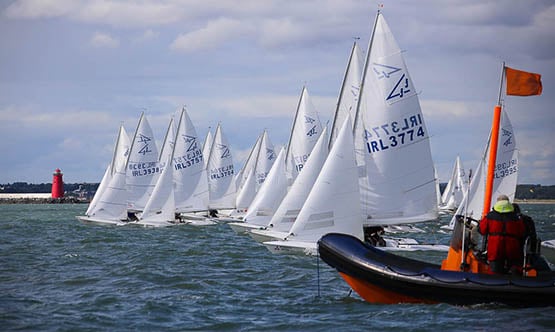
Just about as one design as they could be – the fine fleet at last weekend’s Flying Fifteen Irish Championship in Dublin Bay showed the vigour of the class, which has 47 ranked helmsmen in this country.
Yet you couldn’t be more utterly wrong. Today’s Flying Fifteens may have been technically refined to the ultimate degree to give maximum sport for the minimum of hassle. But their current runaway success – they’re far and away the biggest keelboat One Design class in Dublin Bay – is down to a friendly and very active local class association, and its readiness to reach out the hand of friendship and encouragement to anyone who might be thinking of joining the class’s ranks.
Recently the pace has been set by class captain Ronan Beirne, who recognises that simply announcing and advertising an event is not enough. You have to chivvy people and encourage them into their sailing – particularly after a summer remembered as having had bad weather – and then far from sitting back and smugly counting numbers, you have to keep at it, seeing that crewing gaps are filled, and that those on the fringes are brought to the centre.
The Flying Fifteens – which are essentially a National YC class – offer exceptional value and a very manageable package. The boats are dry-sailed in their road trailers, and instead of queuing for a crane, they have a rapid rota of slip-launching, with the expectation of renewing the wheel bearings each year. Salt water and road trailers are not good partners, but in order to ensure the most efficient launching and retrieval of the boats after each day’s racing, replacing wheel bearings has become something of an art.
The class in Dun Laoghaire secured good sponsorship from Mitsubishi Motors at the beginning of the year, and the sponsors in turn have been rewarded by a thriving class in which inter-personal friendships have developed to such a healthy state that you might find people crewing for someone who would be a complete and untouchable rival at other times in many other classes, but in the Dun Laoghaire Flying Fifteens he’s a fellow enthusiast who happens to be short of a crew on that day.
One of the enthusiastic newcomers to the class this year is Brian O’Neill, who originally hailed from Malahide and was best known for campaigning the family’s Impala 28 Wild Mustard with great success for several years, but now he’s very much a family man living in Dun Laoghaire with three growing kids, and sailing had gone on to the back burner.
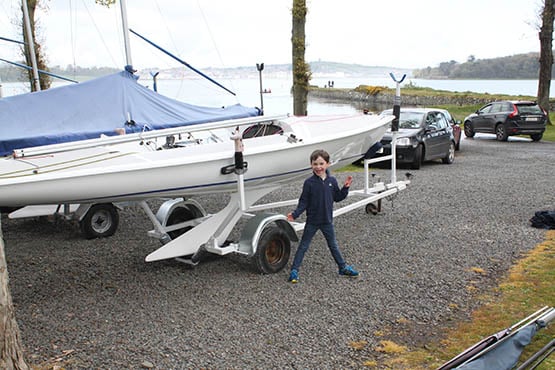
Charlie O’Neill (aged 7) at Strangford SC with dad Brian’s newly acquired Flying Fifteen. Under the rapid moving launching system at the National YC, the dry-sailed Flying Fifteens use their road trailers to get the boats afloat in record time. The need for regular replacement of the wheel bearings is allowed for in each boat’s budget. Photo: Brian O’Neill
But as the National YC is just down the road from where he lives, he was drawn into its welcoming ambience, and soon became aware of the attractive and friendly package offered within the club by the Flying Fifteens. He bought one in good order from an owner at Strangford Sailing Club in the Spring, and was soon in the midst of it. Yet it takes up only a very manageable amount of his time, it simply couldn’t be more convenient, and the people are just great too.
Who knows, but having won the class’s last evening race of the 2015 season, he might even be prepared to travel to maybe one event at another venue in Ireland. But the primary attraction continues to be the class’s strong local ethos and ready racing at the National, the friendliness of fellow Flying Fifteen sailors, and the sheer manageability of the whole thing – this is not a boat where the ownership gets on top of you.
If you want to get the flavour of Dun Laoghaire Flying Fifteen racing, you get a heightened sense of it from the report in Afloat.ie of how David Gorman and Chris Doorly won last weekend’s Irish championship in classic style, and if this isn’t good value in sailing and personal boat ownership, then I don’t know what is.
Across Dublin Bay in those misty waters of Fingal beyond the Baily, your correspondent found himself reporting aboard Alan “Algy” Pearson’s Puppeteer 22 Trick or Treat last Saturday for the opening race of the MSL Park Motors Autumn League. I did so with some trepidation, for Alan has a super young crew recruited from Sutton Dinghy Club in the form of GP14 ace Alan Blay, Ryan Sinnott and Claud Mollard, but our cheerful skipper said that as the day was brisk, they needed the fifth on board for ballast.
In fact, I’d only once raced a Puppeteer before, in the lightest of winds when somehow we managed a win. But as this race progressed with the skipper and his young tacticians making a perfect call for the long beat in a good long course which made full use of the splendid sailing waters north of Howth, by the last leg after many place changes it looked as though another win might be on the cards.

Action stations. Puppeteer 22s closing in for their start. Photo: W M Nixon
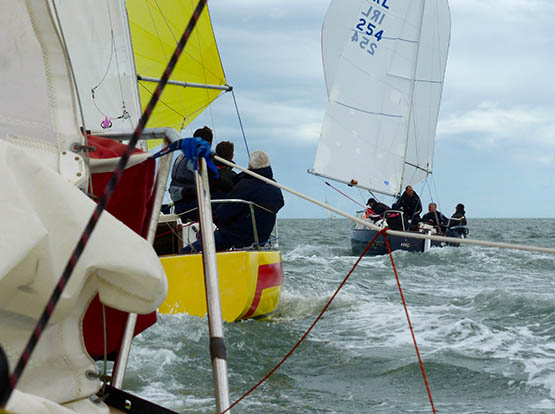
At mid-race, Gold Dust led narrowly from Yellow Peril, but by the start of the last beat, Trick or Treat was leading from Gold Dust with Yellow Peril third. Photo: W M Nixon
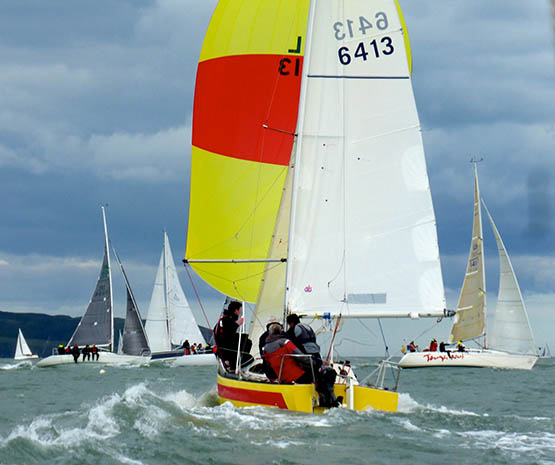
In the MSL Park Motors Autumn League, the mix of classes can sometimes make for interesting situations. Having out-gybed Gold Dust, Yellow Peril is ploughing towards some biggies on another course altogether, and meanwhile there’s the inevitable lobster pot lurking on the way with just one tiny white marker buoy. Photo: W M Nixon
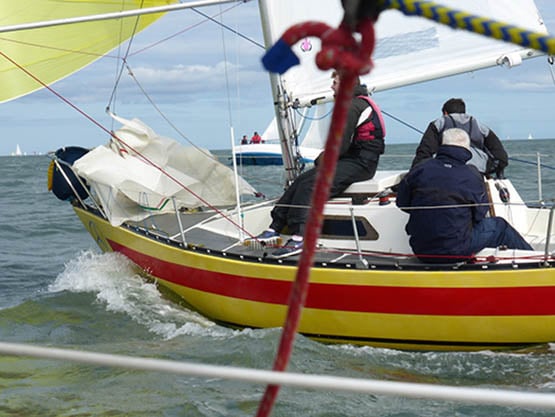
Algy Pearson’s Trick or Treat giving Yellow Peril a hard time to snatch the lead, which she then increased with a cleverly-read long beat. Photo: W M Nixon
But the pace in the Puppeteers is ferocious, and though we’d got a bit of a gap between Trick and former IDRA 14 empress Scorie Walls in Gold Dust, one sneeze from us and Gold Dust would pounce, and alas - we sneezed.
As long as we were carrying the no 2 headsail (what I’d call the working jib) we were level pegging with the formidable Walls-Browne team. But Gold Dust has a lovely new suit of sails (nice ones, Prof), and when the easing wind meant we’d to change up to the genoa, it emerged as a sail of a certain age, and having it set sapped our confidence.
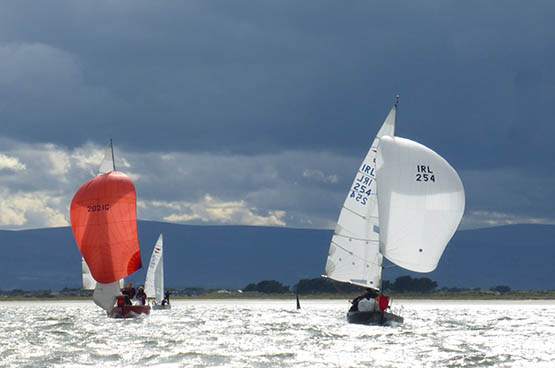
It looked for a while as though Gold Dust (254) had been put fairly comfortably astern……..Photo: W M Nixon
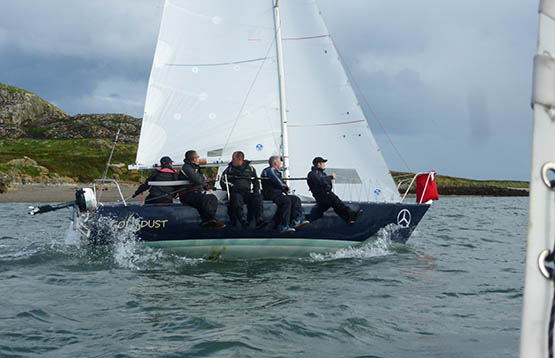
……but an easing of the wind saw Gold Dust finding new speed, and with perfect tactics she was right there with just a hundred metres to go to the finish. Photo: W M Nixon
Until then, the boat had been sailed magnificently, tactics right, trim right, and throwing gybes with such style that the downwind pace never missed a beat. But trying to get that genoa right was a mild distraction, so when Scorie the Queen of the Nile came round the final mark to chase us up the last beat to weather Ireland’s Eye, we’d failed to throw a precautionary tack to keep a loose cover, and suddenly as she rounded she found a local favourable but brief shift of 15 to 20 degrees, and then it was all to play for.
Dissecting it all afterwards (you’ll gather it was a post mortem), we could see two places where we might have still saved the day, but we didn’t grab them, or maybe in truth they were beyond our reach. Whatever, Gold Dust was in the groove and we weren’t. Madam beat us by three seconds. But the banter afterwards and the evidence that Puppeteer people – owners and crews alike – move happily among boats to keep turnout numbers up, was ample proof that here was another truly community based class which perfectly meets a strong local need.

That winning feeling…..Gold Dust’s crew relax after taking first by three seconds. Photo: W M Nixon

The Howth experience. Howth YC Commodore Brian Turvey heads back to port after racing the MSL Autumn League with the Howth 17 Isobel which he co-owns with his brother Conor. Photo: W M Nixon
It had been a great day’s sport, and the Puppeteers being of an age and regularly turning out to race together, they run both a scratch and a handicap system, which is a great improver of local classes – after all, where would golf be without handicaps?
It shows how well Gold Dust has been going this year that her rating is such that we beat her on handicap by one minute and 19 seconds, but we in turn, having been second on scratch, were fourth on handicap, where the winner was the O’Reilly/McDyer team with Geppeto.
Forty years after they first appeared, the Puppeteer 22s are giving better sport than ever, but in a very local context rather than on the bigger stage that might have been anticipated. Yet for their current owners, they do the business and then some. For most folk, this is sailing as it should be. And as to this longterm success of classes which continue to thrive whether they come from a local, national or international background, certainly the quality of the boats is important to some extent. But mostly, it’s the people involved, and their realization that you’ll only get as much out of sailing as you put into it.
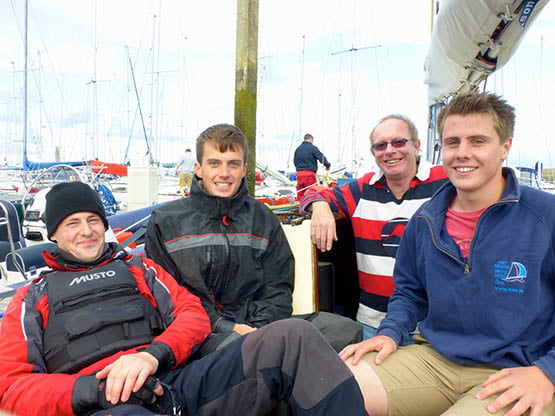
A super crew. Aboard Trick or Treat after racing are (left to right) Alan Blay, Ryan Sinnott, Alan Pearson and Claud Mollard. Photo: W M Nixon

Local man, local boat. Algy Pearson with his Puppeteer 22 Trick or Treat. The Pearsons have been sailng from Howth for three generations. Photo: W M Nixon



























